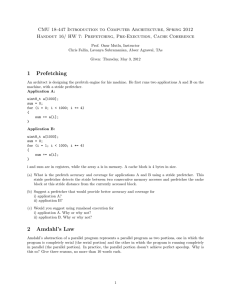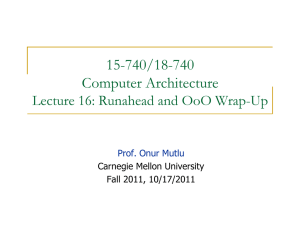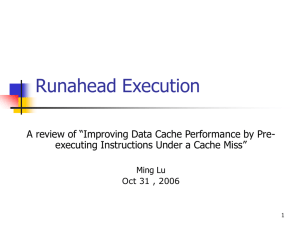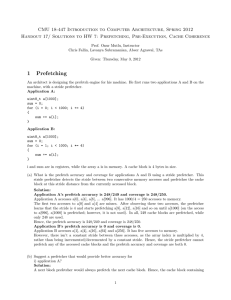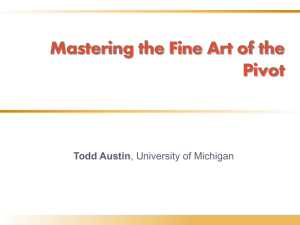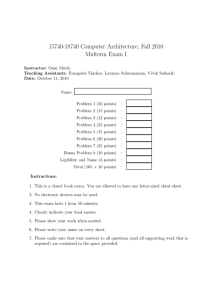18-447: Computer Architecture Lecture 23: Tolerating Memory Latency II Prof. Onur Mutlu
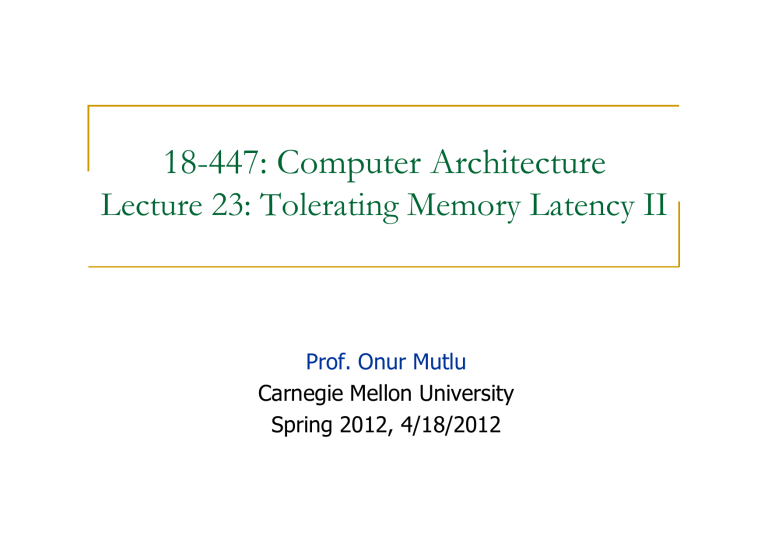
18-447: Computer Architecture
Lecture 23: Tolerating Memory Latency II
Prof. Onur Mutlu
Carnegie Mellon University
Spring 2012, 4/18/2012
Reminder: Lab Assignments
Lab Assignment 6
Implementing a more realistic memory hierarchy
L2 cache model
DRAM, memory controller models
MSHRs, multiple outstanding misses
Due April 23
2
Last Lecture
Memory latency tolerance/reduction
Stalls
Four fundamental techniques
Software and hardware prefetching
Prefetcher throttling
3
Today
More prefetching
Runahead execution
4
Readings
Srinath et al., “ Feedback directed prefetching ”, HPCA 2007.
Mutlu et al., “ Runahead execution ”, HPCA 2003.
5
Tolerating Memory Latency
How Do We Tolerate Stalls Due to Memory?
Two major approaches
Reduce/eliminate stalls
Tolerate the effect of a stall when it happens
Four fundamental techniques to achieve these
Prefetching
Multithreading
Out-of-order execution
Many techniques have been developed to make these four fundamental techniques more effective in tolerating memory latency
7
Prefetching
Review: Prefetching: The Four Questions
What
What addresses to prefetch
When
When to initiate a prefetch request
Where
Where to place the prefetched data
How
Software, hardware, execution-based, cooperative
9
Review: Challenges in Prefetching: How
Software prefetching
ISA provides prefetch instructions
Programmer or compiler inserts prefetch instructions (effort)
Usually works well only for “ regular access patterns ”
Hardware prefetching
Hardware monitors processor accesses
Memorizes or finds patterns/strides
Generates prefetch addresses automatically
Execution-based prefetchers
A “ thread ” is executed to prefetch data for the main program
Can be generated by either software/programmer or hardware
10
How to Prefetch More Irregular Access Patterns?
Regular patterns: Stride, stream prefetchers do well
More irregular access patterns
Indirect array accesses
Linked data structures
Multiple regular strides (1,2,3,1,2,3,1,2,3,…)
Generalized prefetcher for all patterns?
Correlation based prefetchers
Content-directed prefetchers
Precomputation or execution-based prefetchers
11
Markov Prefetching (I)
Consider the following history of cache block addresses
A, B, C, D, C, E, A, C, F, F, E, A, A, B, C, D, E, A, B, C, D, C
After referencing a particular address (say A or E), are some addresses more likely to be referenced next
D
.33
.67
.6
1.0
E
.2
.5
.2
F
.5
Markov
Model
12
Markov Prefetching (II)
Cache
Block
Addr
Cache Block Addr
(tag)
…….
Prefetch
Candidate 1
…….
Confidence ….
….
Prefetch
Candidate N
…… .… …….
….
Confidence
……
Idea: Record the likely-next addresses (B, C, D) after seeing an address A
Next time A is accessed, prefetch B, C, D
A is said to be correlated with B, C, D
Prefetch accuracy is generally low so prefetch up to N next addresses to increase coverage
Prefetch accuracy can be improved by using multiple addresses as key for the next address: (A, B) (C)
(A,B) correlated with C
Joseph and Grunwald, “ Prefetching using Markov Predictors , ” ISCA 1997.
13
Markov Prefetching (III)
Advantages:
Can cover arbitrary access patterns
Linked data structures
Streaming patterns (though not so efficiently!)
Disadvantages:
Correlation table needs to be very large for high coverage
Recording every miss address and its subsequent miss addresses is infeasible
Low timeliness : Lookahead is limited since a prefetch for the next access/miss is initiated right after previous
Consumes a lot of memory bandwidth
Especially when Markov model probabilities (correlations) are low
Cannot reduce compulsory misses
14
Content Directed Prefetching (I)
A specialized prefetcher for pointer values
Cooksey et al., “ A stateless, content-directed data prefetching mechanism , ” ASPLOS 2002.
Idea: Identify pointers among all values in a fetched cache block and issue prefetch requests for them.
+ No need to memorize/record past addresses!
+ Can eliminate compulsory misses (never-seen pointers)
-- Indiscriminately prefetches all pointers in a cache block
How to identify pointer addresses:
Compare address sized values within cache block with cache block ’ s address if most-significant few bits match, pointer
15
Content Directed Prefetching (II)
X800 22220
=
[31:20]
=
[31:20] x40373551
[31:20]
= =
[31:20]
=
[31:20]
=
[31:20]
=
[31:20]
=
[31:20]
Generate Prefetch
X80022220
…
L2 DRAM
…
16
Making Content Directed Prefetching Efficient
Hardware does not have enough information on pointers
Software does (and can profile to get more information)
Idea:
Compiler profiles and provides hints as to which pointer addresses are likely-useful to prefetch .
Hardware uses hints to prefetch only likely-useful pointers .
Ebrahimi et al., “ Techniques for Bandwidth-Efficient
Prefetching of Linked Data Structures in Hybrid Prefetching
Systems , ” HPCA 2009.
17
Shortcomings of CDP – An example
}
HashLookup(int Key) {
… for (node = head ; node -> Key != Key; node = node -> Next; if (node) return node->D1;
) ;
}
Struct node{ int Key; int * D1_ptr; int * D2_ptr; node * Next;
Key
Key
Key
Key
D1
D2
D1
D2
D1
D2
…
Key
Key
D1
D2
D1
D2
…
Example from mst
18
Shortcomings of CDP – An example
Cache Line Addr
Key D1_ptr D2_ptr
[31:20] [31:20] [31:20]
Next
[31:20]
= = = =
Key
[31:20]
D1_ptr D2_ptr
[31:20] [31:20]
Next
[31:20]
= = = =
Key
Key
Key
D1
D2
D1
D2
D1
D2
…
…
Key
Key
D1
D2
D1
D2
…
19
Shortcomings of CDP – An example
}
HashLookup(int Key) {
… for (node = head ; node -> Key != Key; node = node -> Next; if (node) return node -> D1;
) ;
Key
Key
Key
D1
D2
D1
D2
D1
D2
…
Key
Key
D1
D2
D1
D2
…
20
Shortcomings of CDP – An example
Cache Line Addr
Key D1_ptr D2_ptr Next
[31:20] [31:20] [31:20] [31:20]
= = = =
Key D1_ptr D2_ptr Next
[31:20] [31:20] [31:20] [31:20]
= = = =
Key
Key
Key
D1
D2
D1
D2
D1
D2
…
…
Key
Key
D1
D2
D1
D2
…
21
Execution-based Prefetchers (I)
Idea: Pre-execute a piece of the (pruned) program solely for prefetching data
Only need to distill pieces that lead to cache misses
Speculative thread: Pre-executed program piece can be considered a “ thread ”
Speculative thread can be executed
On a separate processor/core
On a separate hardware thread context (think fine-grained multithreading)
On the same thread context in idle cycles (during cache misses)
22
Execution-based Prefetchers (II)
How to construct the speculative thread:
Software based pruning and “ spawn ” instructions
Hardware based pruning and “ spawn ” instructions
Use the original program (no construction), but
Execute it faster without stalling and correctness constraints
Needs to discover misses before the main program
Avoid waiting/stalling and/or compute less
To get ahead, uses
Perform only address generation computation, branch prediction, value prediction (to predict “unknown” values)
23
Thread-Based Pre-Execution
Dubois and Song, “ Assisted
Execution , ” USC Tech
Report 1998.
Chappell et al.,
“ Simultaneous Subordinate
Microthreading (SSMT) , ”
ISCA 1999.
Zilles and Sohi, “ Executionbased Prediction Using
Speculative Slices ” , ISCA
2001.
24
Thread-Based Pre-Execution Issues
Where to execute the precomputation thread?
1. Separate core (least contention with main thread)
2. Separate thread context on the same core (more contention)
3. Same core, same context
When the main thread is stalled
When to spawn the precomputation thread?
1. Insert spawn instructions well before the “ problem ” load
How far ahead?
Too early: prefetch might not be needed
Too late: prefetch might not be timely
2. When the main thread is stalled
When to terminate the precomputation thread?
1. With pre-inserted CANCEL instructions
2. Based on effectiveness/contention feedback
25
Thread-Based Pre-Execution Issues
Read
Luk, “ Tolerating Memory Latency through Software-Controlled
Pre-Execution in Simultaneous Multithreading Processors , ”
ISCA 2001.
Many issues in software-based pre-execution discussed
26
An Example
27
Example ISA Extensions
28
Results on an SMT Processor
29
Problem Instructions
Zilles and Sohi, “ Execution-based Prediction Using Speculative Slices ” , ISCA
2001.
Zilles and Sohi, ” Understanding the backward slices of performance degrading instructions ,” ISCA 2000.
30
Fork Point for Prefetching Thread
31
Pre-execution Slice Construction
32
Runahead Execution (I)
A simple pre-execution method for prefetching purposes
When the oldest instruction is a long-latency cache miss:
Checkpoint architectural state and enter runahead mode
In runahead mode:
The purpose of pre-execution is to generate prefetches
L2-miss dependent instructions are marked INV and dropped
Runahead mode ends when the original miss returns
Checkpoint is restored and normal execution resumes
Mutlu et al., “ Runahead Execution: An Alternative to Very Large
Instruction Windows for Out-of-order Processors , ” HPCA 2003.
33
Runahead Execution (Mutlu et al., HPCA 2003)
Small Window:
Load 1 Miss
Compute
Miss 1
Stall
Load 2 Miss
Compute
Miss 2
Stall
Runahead:
Load 1 Miss Load 2 Miss Load 1 Hit
Compute
Miss 1
Runahead
Miss 2
Load 2 Hit
Compute
Saved Cycles
34
Runahead Execution
Small Windows: Full-window Stalls
Oldest
8-entry instruction window:
L2 Miss! Takes 100s of cycles.
LOAD R1 mem[R5]
BEQ R1, R0, target
ADD R2 R2, 8
LOAD R3 mem[R2]
MUL R4 R4, R3
ADD R4 R4, R5
STOR mem[R2] R4
ADD R2 R2, 64
Independent of the L2 miss, executed out of program order,
LOAD R3 mem[R2]
Younger instructions cannot be executed because there is no space in the instruction window.
The processor stalls until the L2 Miss is serviced.
L2 cache misses are responsible for most full-window stalls.
36
Impact of L2 Cache Misses
100
95
90
85
80
75
70
65
60
55
50
45
40
35
30
25
20
15
10
5
0
L2 Misses
Non-stall (compute) time
Full-window stall time
128-entry window
512KB L2 cache, 500-cycle DRAM latency, aggressive stream-based prefetcher
Data averaged over 147 memory-intensive benchmarks on a high-end x86 processor model
37
Impact of L2 Cache Misses
100
95
90
85
80
75
70
65
60
55
50
45
40
35
30
25
20
15
10
5
0
L2 Misses
Non-stall (compute) time
Full-window stall time
128-entry window 2048-entry window
500-cycle DRAM latency, aggressive stream-based prefetcher
Data averaged over 147 memory-intensive benchmarks on a high-end x86 processor model
38
The Problem
Out-of-order execution requires large instruction windows to tolerate today’s main memory latencies.
As main memory latency increases, instruction window size should also increase to fully tolerate the memory latency.
Building a large instruction window is a challenging task if we would like to achieve
Low power/energy consumption (tag matching logic, ld/st buffers)
Short cycle time (access, wakeup/select latencies)
Low design and verification complexity
39
Efficient Scaling of Instruction Window Size
One of the major research issues in out of order execution
How to achieve the benefits of a large window with a small one (or in a simpler way)?
40
Memory Level Parallelism (MLP)
Idea: Find and service multiple cache misses in parallel so that the processor stalls only once for all misses isolated miss parallel miss
B time
Enables latency tolerance: overlaps latency of different misses
How to generate multiple misses?
Out-of-order execution, multithreading, runahead, prefetching
41
Runahead Execution (I)
A technique to obtain the memory-level parallelism benefits of a large instruction window
When the oldest instruction is a long-latency cache miss:
Checkpoint architectural state and enter runahead mode
In runahead mode:
Speculatively pre-execute instructions
The purpose of pre-execution is to generate prefetches
L2-miss dependent instructions are marked INV and dropped
Runahead mode ends when the original miss returns
Checkpoint is restored and normal execution resumes
Mutlu et al., “ Runahead Execution: An Alternative to Very Large
Instruction Windows for Out-of-order Processors , ” HPCA 2003.
42
Runahead Example
Perfect Caches:
Load 1 Hit Load 2 Hit
Compute Compute
Small Window:
Load 1 Miss Load 2 Miss
Miss 1 Miss 2
Runahead:
Load 1 Miss Load 2 Miss Load 1 Hit
Compute
Miss 1
Runahead
Miss 2
Load 2 Hit
Compute
Saved Cycles
Benefits of Runahead Execution
Instead of stalling during an L2 cache miss:
Pre-executed loads and stores independent of L2-miss instructions generate very accurate data prefetches :
For both regular and irregular access patterns
Instructions on the predicted program path are prefetched into the instruction/trace cache and L2.
Hardware prefetcher and branch predictor tables are trained using future access information.
Runahead Execution Mechanism
Entry into runahead mode
Checkpoint architectural register state
Instruction processing in runahead mode
Exit from runahead mode
Restore architectural register state from checkpoint
Instruction Processing in Runahead Mode
Load 1 Miss
Compute
Miss 1
Runahead
Runahead mode processing is the same as normal instruction processing, EXCEPT:
It is purely speculative: Architectural (software-visible) register/memory state is NOT updated in runahead mode.
L2-miss dependent instructions are identified and treated specially.
They are quickly removed from the instruction window.
Their results are not trusted.
L2-Miss Dependent Instructions
Load 1 Miss
Compute
Miss 1
Runahead
Two types of results produced: INV and VALID
INV = Dependent on an L2 miss
INV results are marked using INV bits in the register file and store buffer.
INV values are not used for prefetching/branch resolution.
Removal of Instructions from Window
Load 1 Miss
Compute
Miss 1
Runahead
Oldest instruction is examined for pseudo-retirement
An INV instruction is removed from window immediately.
Pseudo-retired instructions free their allocated resources.
This allows the processing of later instructions.
Pseudo-retired stores communicate their data to dependent loads.
Store/Load Handling in Runahead Mode
Load 1 Miss
Compute
Miss 1
Runahead
A pseudo-retired store writes its data and INV status to a dedicated memory, called runahead cache .
Purpose: Data communication through memory in runahead mode.
A dependent load reads its data from the runahead cache.
Does not need to be always correct Size of runahead cache is very small.
Branch Handling in Runahead Mode
Load 1 Miss
Compute
Miss 1
Runahead
INV branches cannot be resolved.
A mispredicted INV branch causes the processor to stay on the wrong
VALID branches are resolved and initiate recovery if mispredicted.
Runahead Execution Pros and Cons
Advantages:
+ Very accurate prefetches for data/instructions (all cache levels)
+ Follows the program path
+ Simple to implement , most of the hardware is already built in
+ Versus other pre-execution based prefetching mechanisms:
+ Uses the same thread context as main thread, no waste of context
+ No need to construct a pre-execution thread
Disadvantages/Limitations:
-Extra executed instructions
-- Limited by branch prediction accuracy
-- Cannot prefetch dependent cache misses. Solution?
-Effectiveness limited by available “ memory-level parallelism ” (MLP)
-Prefetch distance limited by memory latency
Implemented in IBM POWER6, Sun “ Rock ”
51
We did not cover the following slides in lecture.
These are for your preparation for the next lecture.
Performance of Runahead Execution
0.3
0.2
0.1
0.0
0.6
0.5
0.4
1.3
1.2
1.1
1.0
0.9
0.8
12%
35%
S95
13%
15%
22%
No prefetcher, no runahead
Only prefetcher (baseline)
Only runahead
Prefetcher + runahead
12%
16% 52%
FP00 INT00 WEB MM PROD SERV WS
22%
AVG
53
Runahead Execution vs. Large Windows
1.5
1.4
1.3
1.2
1.1
1.0
0.9
0.7
0.6
0.5
0.4
0.3
0.2
0.1
0.0
S95
128-entry window (baseline)
128-entry window with Runahead
256-entry window
384-entry window
512-entry window
WS AVG FP00 INT00 WEB MM PROD SERV
54
Runahead on In-order vs. Out-of-order
0.3
0.2
0.1
0.0
0.6
0.5
0.4
0.9
0.8
0.7
1.3
1.2
15% 10%
1.1
1.0
73% 23%
S95 FP00
73% 16%
INT00
17% 13%
WEB
20% 22%
14% 12%
MM PROD in-order baseline in-order + runahead out-of-order baseline out-of-order + runahead
28% 15%
50% 47%
SERV WS AVG
55
Execution-based Prefetchers (III)
+ Can prefetch pretty much any access pattern
+ Can be very low cost (e.g., runahead execution)
+ Especially if it uses the same hardware context
+ Why? The processsor is equipped to execute the program anyway
+ Can be bandwidth-efficient (e.g., runahead execution)
-- Depend on branch prediction and possibly value prediction accuracy
- Mispredicted branches dependent on missing data throw the thread off the correct execution path
-- Can be wasteful
-- speculatively execute many instructions
-- can occupy a separate thread context
56

